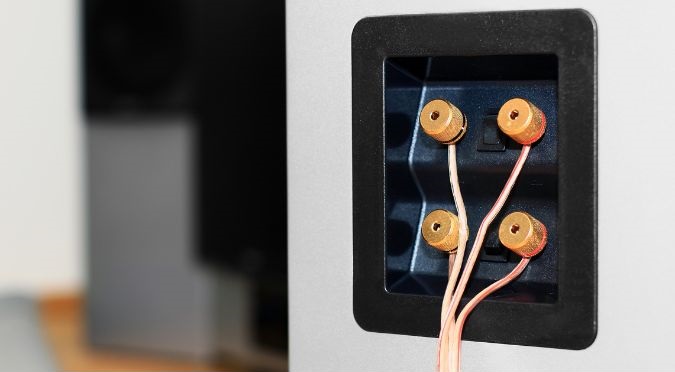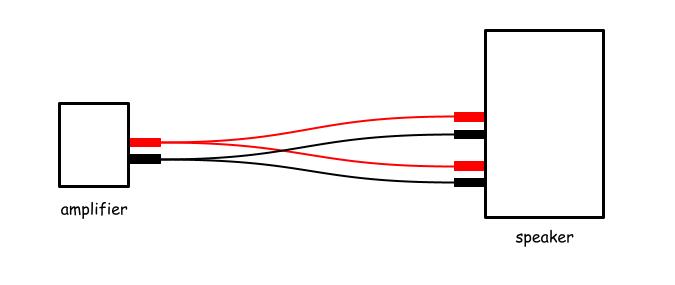
Bi-wiring is yet another item on the long laundry list of speculative ideas in the audio world (which often come with an added price tag) that purportedly enhance sound quality enough to be worth implementing. But does it actually make an audible difference in sound quality? Should you bi-wire speakers or not?
What Does it Mean to Bi-Wire Speakers?
A basic speaker connection will consist of two speaker wires. One wire connects the positive terminals of the amplifier or receiver and the other connects the negative terminals. A very basic explanation as to why there needs to be two wires is that they create an electrical circuit that allows power to flow through the speaker components and make them actually work. Most bookshelf speakers will have two terminals: one for the positive wire and one for the negative wire, and that’s as simple as it needs to be.

Some speakers, though, will have two pairs of positive and negative terminals for a total of four. One pair might be assigned to the tweeter and the other to the woofer.

This extra set of terminals is what allows a speaker to be bi-wired, which simply means you have an two pairs of positive and negative wires connecting the additional speaker terminals back to the amp or receiver, like so:

Speakers that only have one pair of connection terminals – and this is most of them – cannot be bi-wired. You could technically run two wires from a single terminal on your receiver/amp to the corresponding single terminal on your speaker, but that would be like dividing a river into two and rejoining it a mile downstream – practically speaking it doesn’t make a difference.
How to Bi Wire Speakers (That Can Be)
It’s indeed as simple as it sounds and looks on the diagram above: You just connect a second wire to the positive terminal of your amp or receiver and connect it to the additional positive terminal on the speaker, and do the same thing for the additional negative terminal. It’s generally advised that the second pair of wires be exactly the same as the first pair.
So Why Bi-Wire Speakers? How Would That Improve Sound Quality (Allegedly)?
There are a lot of suspiciously vague explanations as to what bi-wiring actually does and how that could translate to an audible improvement in sound quality, but the gist of it – as far as we can gather – is that by “separating” the bass and mid/treble signal into different wires, they can more “cleanly” travel through it and ultimately generate better sound.
That might seem theoretically credible, but in reality speaker connections don’t work that way and that doesn’t actually even really make sense. You’ll see why if we address the seemingly common answers people give when the question “is bi-wiring worth it?” is asked.
Claimed bi-wiring benefit #1: bi-wiring doubles the amount of cable, which reduces the overall impedance, which can improve the signal quality, which ultimately improves the sound.
This assumes that cable impedance is an issue to begin with, which there’s a 99% chance it isn’t unless you’re using cable that is for some reason really old, crappy, thin (e.g. high gauge), or damaged. Decreasing impedance with an extra cable is like adding a parallel road to an existing road that never experiences traffic jams – it’s moot.
Claimed bi-wiring benefit #2: bi-wiring prevents lower bass signals from “overpowering” higher frequency signals.
That’s just not how a speaker level electrical signal coming out of an amp/receiver works at all. High and low frequencies do not travel along speaker wire “separately.” An analog signal is, technically speaking, a singular periodic function. Once inside the speaker, the signal is split in two (but is still the same on each new path) then the lows and highs are filtered out of each with a capacitor and coil as part of a what’s called a crossover then sent to the tweeter and woofer respectively.
Claimed bi-wiring benefit #3: bi-wiring improves sound by bypassing the speaker’s crossover
You cannot “skip” the crossover inside a speaker nor would doing so ever make sense. All that bi-wiring does is send the same signal to the speaker two times, which gets rejoined before it goes through the crossover then gets filtered to the tweeter and woofer all the same. Remember the splitting river analogy from before.
What About Bi-Amping vs Bi-Wiring?
Bi-amping is distinctly different from bi-wiring in that you’re using two separate amplifiers to send two different signals to the tweeter and woofer of a speaker. There is actually arguable merit in bi-amping a compatible speaker, but, odds are almost certain that the modest bookshelf speaker you’re looking at won’t benefit from it and that you’ll introduce new issues that will actually make the sound worse.
In fact, James Larsen over at Audioholics says that putting dual binding posts on non-elite speakers, a trend that picked up speed sometime in the 1980s and 90s, is something that needs to end.
So why do loudspeaker manufacturers put dual-binding posts in speakers that do not realistically benefit from it? The answer is that it makes the speaker seem fancier and it’s cheap to do … Dual binding posts are more often a means of screwing up the set up of a speaker system rather than an opportunity [to improve] the sound. (source)
How To Wire Speakers With 4 Terminals to a Single Amp or Receiver
The easiest way to wire 4 terminal speakers without bi-wiring is to use what are called jumpers, which are very short connectors that simply bridge a connection between the respective positive/negative terminals. Most speakers with four terminals will come with jumpers included and attached. On the off chance that they don’t, you can get a spare set for fairly cheap. You could even just use short sections of regular speaker wire to get the job done, but that might be a bit of a pain.

Conclusion: Bi-Wiring Is Just Another Audio Myth and Not Worth It
There’s no actual scientifically substantiated or even logical argument that bi-wiring speakers will improve anything in any appreciable way. Most modern popular bookshelf speakers only have two connection terminals and thus cannot be bi-wired anyhow.
